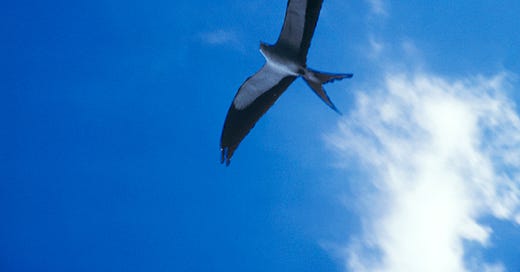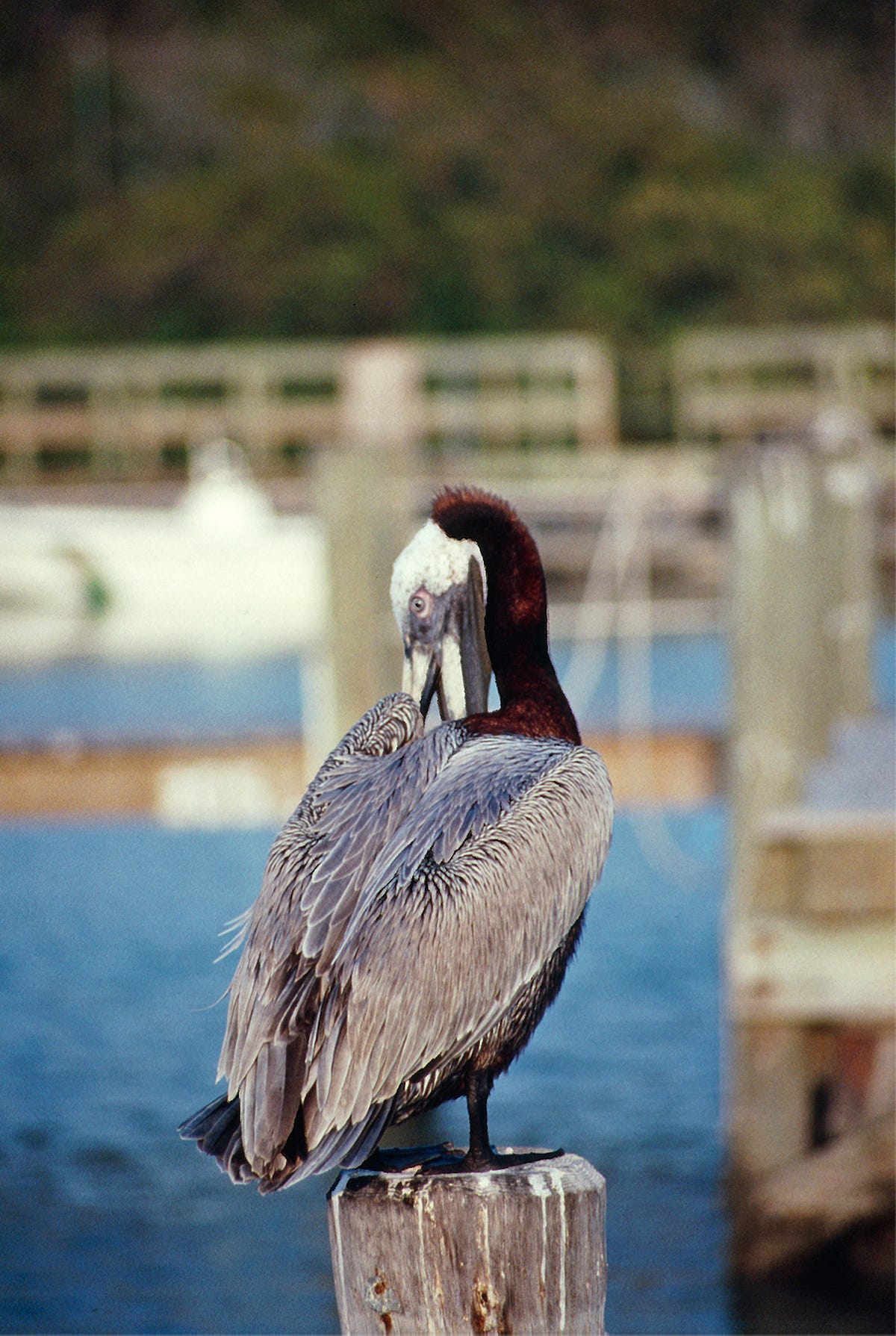Everglades Journal Concluded
The Everglades have changed since I toured in 1991, but this is my story.
Swallow-Tailed Kite photographed by Ray Zimmerman at Everglades National Park.
Eco Pond, Mahogany Hammock, and Nine Mile Pond (March 25)
Someone asked if I had bought a head net. I replied that as a leader, I should not make myself more comfortable than any participant. I then heard that the other participant regarded this as a contest, and she was determined to be the last to buy a net. She reportedly wished I would get one, so she could too. I obliged by buying a head net and wearing it prominently. When the other participant arrived, she dashed into the store and returned with a head net. She bragged about being the last to do so, but my dignity was not offended.
The birdlife at Eco Pond is impressive. The diversity of species and the sheer numbers of birds tell me this is a special place. That morning we saw the American anhinga, great egret, snowy egret, purple gallinule, and osprey. The All About Birds website from the Cornell Laboratory of Ornithology is an excellent reference for unfamiliar names.
I photographed a male painted bunting with red, blue, and yellow plumage. We returned several times, given the proximity of this pond to the hotel, and on one visit, we saw roseate spoonbills.
The Mahogany Hammock has dense tropical growth, including a colossal mahogany tree and several species of shrubs and ferns. Photos of many of the Everglades’ trees are collected on one page of the Everglades National Park website.
I paused to consider the disappearance of mahogany and other tropical hardwoods for consumption by industrial countries. The dense structure and dark color of the mahogany wood make it desirable for furniture production, and five centuries of trade have reduced and eliminated this tropical hardwood in some locations. With trees vanishing from available forests, illegal cutting has increased in parks and other protected areas. The story of this historical trend is available online from Cambridge University Press.
When we ate lunch at the Mahogany Hammock, a raccoon came out of the woods to beg for food. He was very light in color compared to raccoons of the northern latitudes I call home. As the observer travels closer to the tropics, these "wash bears" become light brown. Those in the Florida Keys are almost blond.
Nine Mile Pond was the location of our first trip by canoe. White pelicans, also known as river pelicans, were perched in the trees lining the canoe trail. Roseate Spoonbills were common and turned the sky pink when they all flew.
This area was a transition zone, with freshwater spike rush and predatory bladderwort plants growing among the roots of mangroves, a plant generally limited to salt and brackish water. Years earlier, I encountered the bladderwort plants while canoeing in New Hampshire. I dipped my paddle in the water, and it emerged covered with a mass of green strands. The ladders were green translucent bubbles on the strands, some filled with the dark mass of insect bodies. The bubbles implode when an insect brushes against them and suck in the victim, which the plant slowly digests.
Navigating a canoe across shallow mud is an exercise of brute strength. Still, our reward was a view of incredibly diverse plant and birdlife. A Swallow-tailed Kite flew overhead, the broad forks of the tail making it impossible to misidentify this bird. Soon after the kite passed, an osprey carrying a fish flew overhead.
We saw several cacti among the mangroves. They seemed out of place in this wet setting. I usually associate them with the deserts of the arid southwest. One species that ran through the mangrove forest had strongly ridged stems. It lived as an epiphyte, supported by trees but not hanging down like the Spanish moss.
That evening we made another trip to Eco Pond, where squirrel frogs called with several other frog species. We saw a leopard frog near the viewing platform. The nighttime chorus was exciting, but the real show occurred in the water. The bright eyes of nighttime alligators glared from the water with the reflected light of eyeshine. They swam fast and bellowed, for it was their courtship season.
In the pond's center, a bull 'gator raised his head and slapped it against the water, creating a report like thunder and an incredible splash. Perhaps the lady alligators were impressed with his antics. The alligators' actions that night assured the future of their species, at least for a few more years.
Brown Pelican at the Boat Basin, Everglades National Park. Photo by Ray Zimmerman.
Canals and Lakes: March 26
This day's itinerary was entirely devoted to canoeing on Mud Lake, Coot Bay, and Bear Lake. The wind was stiff, and canoeing difficult. The whitecaps added to our sense of discouragement.
With the stiff wind in our faces, two participants drifted off course and needed to be rescued. They had reached the mangrove forest at the edge of the pond.
When we reached them, one stood on the prop roots of the red mangrove trees that lined the beach, and the other was swimming near an alligator. She had grown up in Mobile and claimed to be familiar with the behavior of alligators. I wondered why she swam in the alligator-infested pond, later learning her actions were due to the lack of a restroom.
With these participants moved to the bows of two separate canoes steered by strong paddlers in the stern of each, we continued our journey. The winds sent the usually ever-present mosquitoes elsewhere.
The canal between Mud Lake and Coot Bay was so dense with mangroves that we had to make sudden turns to avoid the growth. Nevertheless, we saw several Bald Eagles and yet another Swallow-tailed Kite.
Vultures circled the Bear Lake Canal as we approached. One member of our party predicted a dead alligator in the canal. When we arrived, the alligator was bloated, with skin stretched tight by the gases that must have been building up inside the decomposing body.
The gas-filled carcass floated high in the water. The alligator was male, a bull gator, with reproductive organs distended not by hormones but by the gaseous products of decomposition that now controlled its body. One of our guides wanted to investigate the alligator further. The other reminded him that rupturing the body could release expelled gas that might propel chunks of decaying flesh.
The winds and waves conspired to prevent much wildlife observation that day, so we returned to our rooms. We heard someone had spotted an American Crocodile in the boat basin, and I was anxious to see this endangered animal.
The American Crocodile is quite different from the American Alligator, its distant relative we had viewed abundantly on this trip. Where the alligator lives solely in freshwater, the crocodile is quite at home in brackish or saltwater. It has a pointed, angular snout, but the alligator has a rounded one. The crocodile's lower teeth protrude outside the upper lips.
The most significant difference is in the level of danger presented by encountering a crocodile. The alligators of the 'gator holes out in the wet prairies are elusive. They swim or run from approaching humans. The alligators of boardwalks and highly traveled waters are habituated to humans, lounging on banks and emergent vegetation. Humans have even fed some. This familiarity makes them more dangerous, especially when hungry or accompanied by young.
Encountering a crocodile is an entirely different proposition. Crocodiles are aggressive and prone to attack under any circumstances. We observed this crocodile from the opposite shore and saw no movement on its part at all. It could have been a log, except for the baleful green eye that remained open, regarding us with no expression whatsoever.
Florida Bay: March 27
We canoed into Florida Bay at the wrong time of year to search for manatees and sea turtles. One participant had been so eager to come on this trip that she vowed to kiss a manatee if selected. The manatees were congregated in warm estuaries and inland streams. Later in the year, they would return to the coastal waters.
Several stingrays kicked up the sand and moved on as we approached them, and the birdlife was more than impressive. White pelicans perched on mudflats next to their brown cousins. The difference between white and brown pelicans is more than color. The white pelican is gigantic in comparison to the brown.
A large number and variety of sandpipers also populated the mudflats. Bird watchers would appreciate the abundant dunlin, dowitcher, marbled godwit, and willet. The shallows must have been filled with fish, for ospreys fished near us. Two Bald Eagles circled overhead.
We concluded the trip with a landward breeze. We joined the canoes and hoisted our rain ponchos onto the canoe paddles as sails. As we approached the shore, more and more people came out on the dock to see the strange craft approaching them. Their wonderment gave way to laughter when we were close and the crowd on the pier discovered the nature of our boat.
We had devoted previous evenings to informational sessions on the geology, hydrology, and life forms of the Everglades. This evening was for relaxation before the following day's drive to the Miami airport and the flight home.
Brown Pelican at the Boat Basin, Everglades National Park. Photo by Ray Zimmerman.






